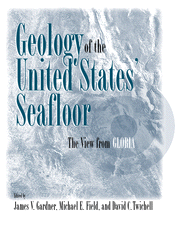Book contents
- Frontmatter
- Contents
- Contributors
- Foreword
- Introduction
- Part I The GLORIA System and Data Processing
- Part II U. S. East Coast EEZ
- Introduction
- 3 The Timing and Spatial Relations of Submarine Canyon Erosion and Mass Movement on the New England Continental Slope and Rise
- 4 Characteristics of the Continental Slope and Rise off North Carolina from GLORIA and Seismic-Reflection Data: The Interaction of Downslope and Contour Current Processes
- Part III Gulf of Mexico and Caribbean EEZ
- Part IV U. S. West Coast EEZ
- Part V Alaskan EEZ
- Index
Introduction
Published online by Cambridge University Press: 25 January 2010
- Frontmatter
- Contents
- Contributors
- Foreword
- Introduction
- Part I The GLORIA System and Data Processing
- Part II U. S. East Coast EEZ
- Introduction
- 3 The Timing and Spatial Relations of Submarine Canyon Erosion and Mass Movement on the New England Continental Slope and Rise
- 4 Characteristics of the Continental Slope and Rise off North Carolina from GLORIA and Seismic-Reflection Data: The Interaction of Downslope and Contour Current Processes
- Part III Gulf of Mexico and Caribbean EEZ
- Part IV U. S. West Coast EEZ
- Part V Alaskan EEZ
- Index
Summary
The USGS and the British Institute of Oceanographic Sciences (IOS) first surveyed parts of the U.S. East Coast continental slope between Georges Bank and the Blake Escarpment using GLORIA during October and November of 1979. That early survey gave Twichell and Roberts (1982) a new look at the overall geomorphic pattern of submarine canyons on the mid-Atlantic continental slope. They could see that many canyons extend only partially across the mid or lower slope. Therefore, some submarine canyons can be created on the continental slope, without connection to the shelf edge and independently of shelf or shallow water processes. That insight inspired other studies and led to major conceptual advances in the understanding of submarine canyon origins and growth.
The EEZ-SCAN survey of the U.S. East Coast areas took place from February to May 1987, using a much superior GLORIA system, which recorded the data in digital form rather than as analog photographic records. The 1979 images had been as tantalizing as they were effective; they provided a new, broad view, but commonly lacked enough contrast to show the details clearly. The digital processing techniques available eight years later produced much clearer images that could be readily manipulated and combined with other data, such as bathymetry.
In the spring of 1987, survey operations proceeded aboard R/V Farnella during five periods, each about twenty-five days in length, beginning off Georgia and working northeastward.
- Type
- Chapter
- Information
- Geology of the United States' SeafloorThe View from GLORIA, pp. 43 - 46Publisher: Cambridge University PressPrint publication year: 1996



